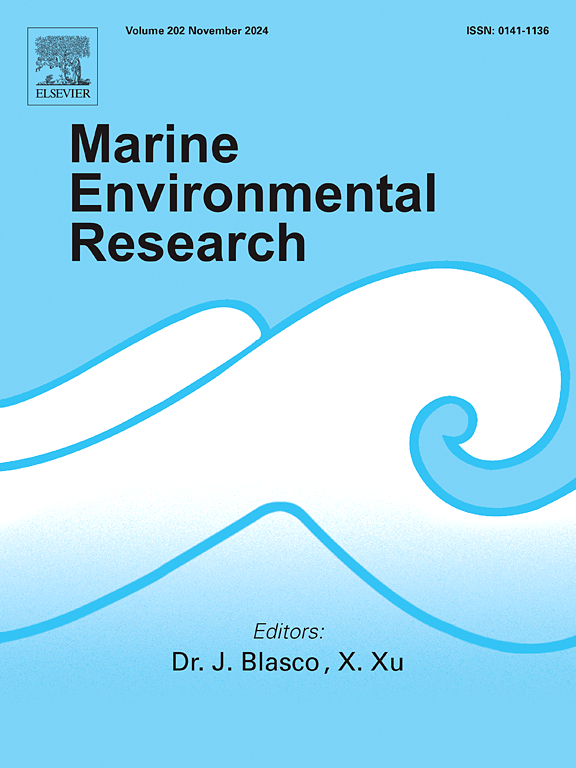Decadal long sub-lethal temperature increases alter the production of non-structural carbohydrates in Zostera muelleri
IF 3
3区 环境科学与生态学
Q2 ENVIRONMENTAL SCIENCES
引用次数: 0
Abstract
Globally, seagrass ecosystems are affected by a variety of natural and anthropogenic stressors under a warming climate. Understanding how organisms cope with current stressors, when presented with future warming scenarios, is crucial for predicting ecosystem responses. Here, we use thermal plumes in an east Australian estuary as a proxy for future climate change scenarios to investigate the effects of in situ warming on Zostera muelleri resilience, measured through non-structural carbohydrate (NSC) concentration in the rhizome. NSC's are stored in the rhizome during periods of high photosynthetic efficiency, and are metabolised when photosynthesis is not possible, such as during a storm surge or other stress event. Thermally affected sites in this system experience temperatures 1–6 °C above ambient conditions, with greatest differences in winter months. Despite temperatures frequently exceeding the upper thermal limit (32 °C) for Z. muelleri, we found no significant differences in total NSC concentrations between ambient (80–210 mg g−1) and thermally affected populations (80–170 mg g−1), with only a difference in starch concentration being higher at ambient sites than thermally affected sites during October. A notable shift in NSC composition occurred in July–August 2022 after heavy rainfall in the area, with starch decreasing from 120 to 160 mg g−1 to 20–30 mg g−1, coinciding with increases in fructose and glucose. Thermally affected sites exhibited dampened seasonality in energy reserves suggesting that these populations have adjusted their energy management strategy in response to extended favorable conditions, effectively reducing the amplitude of seasonal NSC fluctuations. These findings support previous findings that larger changes in carbohydrates are driven by temporal patterns and local weather events. They also suggest that Z. muelleri exhibits resilience to elevated temperatures through maintaining comparable total NSC reserves, but with altered temporal patterns of accumulation that likely reflect adaptation to an effectively extended growing season under warming conditions.
年代际长时间的亚致死温度升高改变了穆勒藻非结构性碳水化合物的产生
在全球范围内,在气候变暖的情况下,海草生态系统受到各种自然和人为压力的影响。了解生物在面对未来变暖情景时如何应对当前的压力,对于预测生态系统的反应至关重要。在这里,我们利用东澳大利亚河口的热羽流作为未来气候变化情景的代表,通过根茎中的非结构性碳水化合物(NSC)浓度来研究原位变暖对细叶小狐猴(Zostera muelleri)恢复力的影响。NSC在光合作用效率高的时期储存在根茎中,当光合作用不可能进行时,比如在风暴潮或其他压力事件期间,就会被代谢掉。该系统中受热影响的站点的温度比环境条件高1-6°C,在冬季差异最大。尽管温度经常超过muelleri的热上限(32°C),但我们发现环境(80-210 mg g - 1)和热影响种群(80-170 mg g - 1)之间的总NSC浓度没有显着差异,只有淀粉浓度在10月份环境站点高于热影响站点。2022年7月至8月,该地区强降雨后,NSC成分发生了显著变化,淀粉从120 - 160 mg g - 1减少到20-30 mg g - 1,与果糖和葡萄糖的增加相一致。受热影响的地点表现出能量储备的季节性减弱,这表明这些人口已经调整了他们的能源管理策略,以应对延长的有利条件,有效地减少了季节性NSC波动的幅度。这些发现支持了之前的发现,即碳水化合物的较大变化是由时间模式和当地天气事件驱动的。他们还认为,穆勒菌通过保持相当的NSC总储备来表现出对高温的适应能力,但其积累的时间模式发生了变化,这可能反映了在变暖条件下对有效延长生长季节的适应。
本文章由计算机程序翻译,如有差异,请以英文原文为准。
求助全文
约1分钟内获得全文
求助全文
来源期刊

Marine environmental research
环境科学-毒理学
CiteScore
5.90
自引率
3.00%
发文量
217
审稿时长
46 days
期刊介绍:
Marine Environmental Research publishes original research papers on chemical, physical, and biological interactions in the oceans and coastal waters. The journal serves as a forum for new information on biology, chemistry, and toxicology and syntheses that advance understanding of marine environmental processes.
Submission of multidisciplinary studies is encouraged. Studies that utilize experimental approaches to clarify the roles of anthropogenic and natural causes of changes in marine ecosystems are especially welcome, as are those studies that represent new developments of a theoretical or conceptual aspect of marine science. All papers published in this journal are reviewed by qualified peers prior to acceptance and publication. Examples of topics considered to be appropriate for the journal include, but are not limited to, the following:
– The extent, persistence, and consequences of change and the recovery from such change in natural marine systems
– The biochemical, physiological, and ecological consequences of contaminants to marine organisms and ecosystems
– The biogeochemistry of naturally occurring and anthropogenic substances
– Models that describe and predict the above processes
– Monitoring studies, to the extent that their results provide new information on functional processes
– Methodological papers describing improved quantitative techniques for the marine sciences.
 求助内容:
求助内容: 应助结果提醒方式:
应助结果提醒方式:


